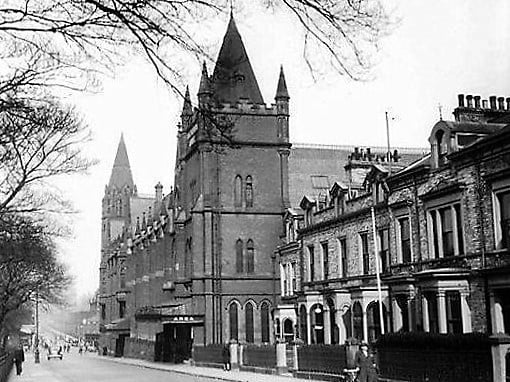
Sunderland
The Victoria Hall, Sunderland
Last Updated:
20 Nov 2025
Sunderland
This is a
Music Hall, Institute
54.903594, -1.378385
Founded in
Current status is
Demolished due to WWII bombing
Designer (if known):
George Gordon Hoskins

Now an insurance firm
Today we focus on one of the worst peacetime disasters in British history, which occurred in our part of the world in 1883. Opposite Mowbray Park is Victoria Hall, where 183 children died due to a stampede. Just a warning that I go into some detail.
The Victoria Hall was opened in 1872, featuring a large hall and temperance institute within. The building could hold upwards of 2500 people and paid for almost in whole by the Backhouse family. You may have heard them if you're from Darlington ends, as they were Quaker bankers involved in the building of the Stockton & Darlington Railway. In fact, Backhouse's Bank were critical in underpinning a ton of industrial ventures, but were merged from 1896 eventually into Barclays.
The building was designed by Mr George Hoskins at a cost of around £9500, featuring this elaborate red brick structure with great high tower almost reminiscent of a Gothic church. Hoskins also designed Middlesbrough's Town Hall, an assortment of banks (which provides us our connection), Darlington's Technical School and Sunderland's old Gas Company Offices which still exist.
The history of the building pales in comparison to the horror which occurred on the 16th June 1883. A travelling magic show with all sorts of tricks and illusions performed to a packed house with 1,100 children in the gallery. The troupe handed out gifts to the children but the kids on the higher levels feared missing out. There wasn't any such protocol or security in those days, so the kids followed each other like buffalo running down the stairs to try obtain the gifts. Unfortunately upon reaching the bottom of the stairs, the doors opened inwards and as a greater amount of kids reached the bottom, there was no one with the strength to open the door. The door had also been bolted to allow one child through at a time for the orderly checking of tickets.
As a result, 183 children aged between 3 and 14 died due to asphyxia. In one school 30 of its children were killed, and at the immediate aftermath of the tragedy the dead and dying were removed by their own parents in anguish. One father carried his children in each arm, and four of Mr Mills' family perished. One little boy, who was rescued by a grown-ups arm, described it was like he was falling to sleep.
The Queen stated she was deeply grieved by the incident and contributed to the disaster fund which totalled the equivalent of about £650,000 today. Some of this money went towards a memorial in Mowbray Park, previously moved to Bishopwearmouth Cemetery but now back in its rightful spot.
It led to legislation that forced public venues to feature a minimum amount of emergency exits, which later led to those push bar doors you see in most buildings.
The building remained until 1941, when it was hit by a bomb and subsequently demolished.
Listing Description (if available)


These Ordnance Surveys depict the Victoria Hall only a decade after the disaster, and a decade after demolition when the plot was cleared. The first, from the 1890s, illustrates the small triangular plot which deceives just how big this building was between Toward Road and Laura Street. For some of the next 50 years it was to stare at the memorial to the children who died inside its corridors.
The next half century in the wider context endured much change also. The neighbourhood adjacent had undergone some clearance, once filled with early 19th century rows now replaced with larger commercial units. You may also notice the Sunderland Docks line which ran through Mowbray Park, but now dismantled.

It's worth going back in time for a snapshot of Sunderland before the Victoria Hall. At this stage it was a simple yard wedged next to Wellington Street (as it was called then). The houses adjacent were opulent and likely reserved for the aspirational classes - not wealthy enough to make it half a mile to Ashbrooke but still doing well for themselves. Perhaps the managers, officials or junior professionals of the growing town.

Victoria Hall today looking south from the Borough Road junction. Taken in October 2025.

This photo gives great scale of the venue. The properties on the right hand side still exist today. Unknown original source.

A side view of the hall. It is said the disaster happened close to the exit which can be seen closest to us, with the ornate iron awning. Unknown original source.
